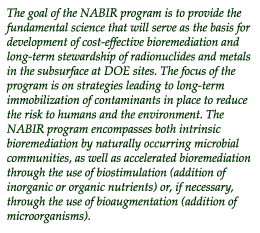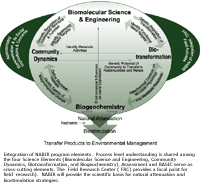| Download the PDF version here.
Strategic Plan Contents:
I. Introduction
II. Program Goals and Management Strategy
III. Science Elements
IV. Cross-Cutting Elements
V. The NABIR Field Research Center (FRC)
VI. Linkages to Genomics Programs in Biological and Environmental Research (BER)
VII. Interface with the DOE Office of Basic Energy Sciences
VIII. Interface with the DOE Office of Environmental Management
IX. Coordination with Other Federal Agencies
X. Points of Contact for NABIR Program |

II. Program Goals and Management Strategy
 A. NABIR PROGRAM GOAL A. NABIR PROGRAM GOAL
NABIR will provide an improved, multidisciplinary understanding of the biogeochemical functioning of the subsurface environment. Sophisticated new findings related to molecular/microscopic workings of mineral-microbe association and their regulation by hydrologic, physical, and other field-scale processes and features will have broad applicability. The science base will enable remediation programs within the Office of Environmental Management, while providing fundamental new insights into the biogeochemical cycling of nutrients, trace elements, and trace gases in subsurface environments.
Natural attenuation is the removal of a contaminant from the aqueous phase or transformation of that contaminant to a less toxic form by natural biological, chemical, and physical processes, without human intervention. The biological component of natural attenuation is sometimes referred to as intrinsic bioremediation. By contrast, accelerated bioremediation involves manipulating the contaminated area to enhance the rates of microbial transformation of hazardous wastes. There are two types of accelerated bioremediation: biostimulation and bioaugmentation. Biostimulation is the addition of nutrients to stimulate natural microbial communities. Bioaugmentation involves the addition of microorganisms with special capabilities, and it is used if the requisite microorganisms for bioremediation are lacking at a site. Bioaugmentation is usually used in conjunction with biostimulation to provide nutrients to enhance the growth of the introduced microorganisms. Bioremediation strategies may in some cases be coupled with existing physicochemical approaches to clean up a contaminated site.
Naturally occurring subsurface microbes may be involved in intrinsic bioremediation of metals and radionuclides by reducing and immobilizing, either directly or indirectly, metal and radionuclide contaminants. However, these natural processes typically occur at fairly slow rates, and there may be a need to use biostimulation. The primary focus of the NABIR program is on biostimulation strategies, due to the ubiquity of metal-reducers in nature. If biostimulation studies show that enhancing the activity of naturally occurring microorganisms is insufficient to immobilize radionuclides and metals, in situ, bioaugmentation approaches will be considered as a possible option for further research.
In situ immobilization of contaminants is one approach to long-term stewardship, which is the post-closure responsibility of DOE at its contaminated sites. Long-term stewardship involves long-term monitoring and other maintenance activities to ensure that residual in-ground contaminants do not spread further. Immobilization is focused on contaminant capture from both vadose zone and groundwater plumes. As such, it may be a strategy applied to prevent the discharge of deep or widely distributed contaminants from the vadose zone to groundwater, or from groundwater to a receiving water body (e.g., the Columbia River at Hanford). Immobilized metals and radionuclides are not removed from the subsurface as may occur with excavation, pump and treat, or biodegradation of organic contaminants. Therefore, an important aspect to the NABIR program is to assess factors controlling the long-term stability of the immobilized contaminants and to devise approaches (biological/chemical) to maintain their immobilization through the stewardship phase. In the future, engineering approaches may be designed to extract the immobilized contaminants that are captured in highly localized, biostimulated zones.
B. NABIR DELIVERABLES
The primary customer for research products from NABIR within the DOE is the Office of Environmental Management/Office of Science and Technology. Within this office, the responsibility for developing new technologies to address contamination in the subsurface at DOE sites falls under the Subsurface Contaminant Focus Area. Other customers may include agencies such as the Department of Defense (DOD) and industries dealing with metal contamination. Deliverables include:
- An integration of the disciplines of microbiology, geosciences and environmental engineering in a manner not previously accomplished. This fundamental understanding of the dynamics of microbial communities will provide the scientific underpinnings required to address a myriad of existing subsurface science problems as well as provide new insights on the biogeochemical cycling of elements on Earth.
- Bioremediation strategies for immobilization of metals and radionuclides in subsurface environments. These immobilization strategies may include intrinsic bioremediation, as part of the natural attenuation of metals and radionuclides, or biostimulation through the addition of key nutrients to accelerate the rate of immobilization of metals and radionuclides in situ.
- Defining the state-of-the-art in bioremediation. Fundamental knowledge will help delineate the limits of technology—what can and cannot be achieved relative to other technologies within the context of disposal site conditions; aid in determining the system attributes and features critical for process optimization and success; and provide the basis for criteria to assess bioremediation effectiveness and regulatory compliance.
- Science-based understanding of biogeochemistry of metals and radionuclides in the subsurface. NABIR is conducting fundamental research on biogeochemistry that is contributing to our overarching understanding of the fate and transport of metals and radionuclides in the subsurface. These findings may be immediately useful in determining the risk to the humans and the environment, developing remediation strategies, and determining cost factors. The knowledge that these studies will supply will also support DOE’s effective long-term stewardship of these sites.
- Innovative tools for determining the bioremediation potential of microbial communities at DOE sites. Novel tools developed by NABIR researchers will ascertain if naturally occurring microorganisms in the subsurface at a contaminated site are genetically and physiologically capable of immobilizing metals and/or radionuclides. These tools may include nucleic acid microarrays for determining microbial community structure and antibody-based biosensors for radionuclides. Innovative approaches such as “push-pull” tests will allow site managers to determine the in situ activity of microbial populations in the subsurface.
C. NABIR PROGRAM STRUCTURE: An Overview
The NABIR Program consists of four closely interrelated Science Elements, two Cross-Cutting Elements, and the Field Research Center. The Science Elements are Biogeochemical Dynamics, Biotransformation, Community Dynamics and Microbial Ecology, and Biomolecular Science and Engineering. A detailed description of each of these Science Elements can be found in Section III. The two Cross-Cutting Elements—Bioremediation and Its Societal Implications and Concerns (BASIC) and Assessment (innovative method development)— are described in Section IV. The NABIR program has established a Field Research Center (FRC) on the U.S. Department of Energy Oak Ridge Reservation in Oak Ridge, Tennessee, at Bear Creek Valley (BCV) within the Y-12 National Security Complex. The FRC is a focal point for integration of process level understanding and field research in the NABIR Program. The FRC provides DOE-relevant samples contaminated with uranium and other radionuclides or metals to researchers. The FRC is described in more detail in Section V. Additional information about the NABIR program can be accessed from the NABIR Web site at http://www.lbl.gov/NABIR/.
 The program elements are highly integrated (See figure at right), and scientific findings are shared among researchers at informal workshops and annual PI meetings. The highly interdisciplinary nature of the program has resulted in most researchers being involved in multiple program elements. Scientific disciplines represented in the program include microbial physiology and ecology, molecular biology, geochemistry, hydrology, and mathematical modeling. The Science Elements provide the basis for understanding intrinsic bioremediation of metals and radionuclides, and for understanding the potential for accelerated bioremediation through biostimulation. NABIR research proposals are evaluated by a process involving a competitive peer review for scientific merit and a review for programmatic relevance by NABIR program managers. The program elements are highly integrated (See figure at right), and scientific findings are shared among researchers at informal workshops and annual PI meetings. The highly interdisciplinary nature of the program has resulted in most researchers being involved in multiple program elements. Scientific disciplines represented in the program include microbial physiology and ecology, molecular biology, geochemistry, hydrology, and mathematical modeling. The Science Elements provide the basis for understanding intrinsic bioremediation of metals and radionuclides, and for understanding the potential for accelerated bioremediation through biostimulation. NABIR research proposals are evaluated by a process involving a competitive peer review for scientific merit and a review for programmatic relevance by NABIR program managers.
Program Phases
The NABIR program is planned as a 10-to-12-year program, consisting of three phases and an optional fourth phase:
Phase I: The goal of the first three years of NABIR was to develop a broad science base for bioremediation of metals and radionuclides, taking advantage of laboratory-based studies and “sites of opportunity” for collection of field samples. This science base included the four science elements and the two cross-cutting elements (Assessment and BASIC), as well as research in bacterial transport, data management, and systems integration. Sites of opportunity included a chromium-contaminated Superfund site at Cannelton, Michigan; Uranium Mill Tailing Remedial Action sites at Shiprock, New Mexico, and Gunnison, Colorado; and a pristine site at Oyster, Virginia, for bacterial transport studies. The Field Research Center (FRC) was selected after extensive peer review and completion of an environmental assessment and finding of no significant impact under the National Environmental Policy Act (NEPA).
Phase II: The Program has now entered Phase II. The goal of Phase II is to conduct hypothesis-driven research to understand biostimulation at the field scale, taking advantage of the FRC at Oak Ridge, Tennessee. NABIR investigators are utilizing samples from the FRC site (or other DOE-relevant sites) for laboratory-based studies on microbial communities in high-uranium/high-nitrate subsurface environments. In addition, several large-scale field experiments are planned, including push-pull and nutrient addition studies. In-depth characterization of the microbiology, geochemistry, and hydrology of the FRC site is in progress.
Phase III: In this phase, synthesis and modeling of data from field experiments at the FRC site will be a priority. Key findings will be applied to related sites, and opportunities to transition NABIR science to EM and other customers, including jointly funded research projects, will be pursued aggressively.
Phase IV (optional): If biostimulation does not effectively immobilize metals and radionuclides in the field, and if data suggest this failure is due to the lack of key microbial populations, a bioaugmentation experiment will be planned at the FRC. If necessary to ensure the survival of introduced microorganisms, bioaugmentation would be combined with biostimulation. Such a bioaugmentation experiment would take advantage of previous NABIR-funded studies on bacterial transport at Oyster, Virginia.
|

